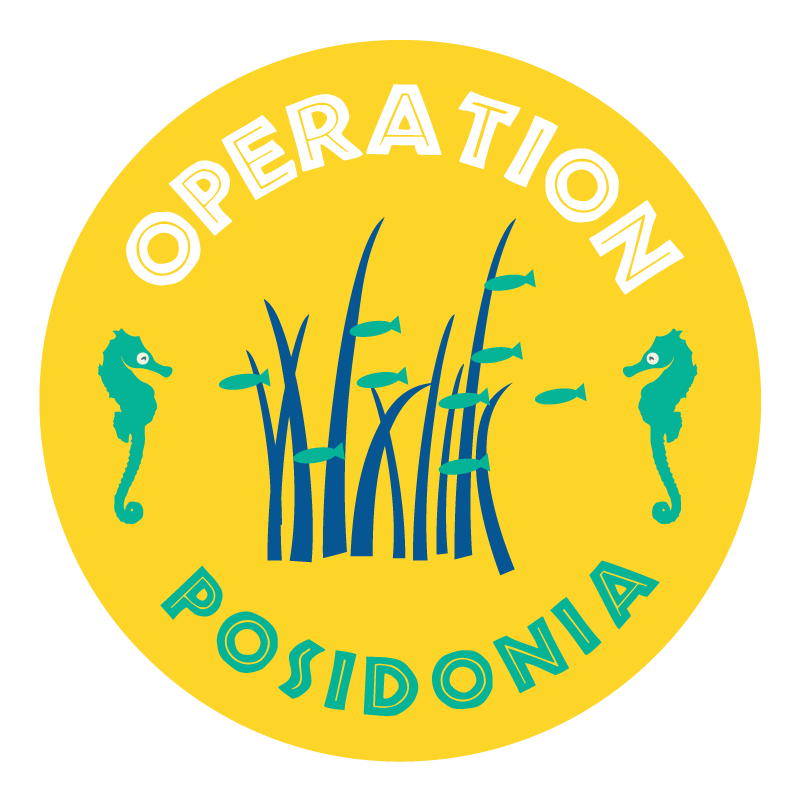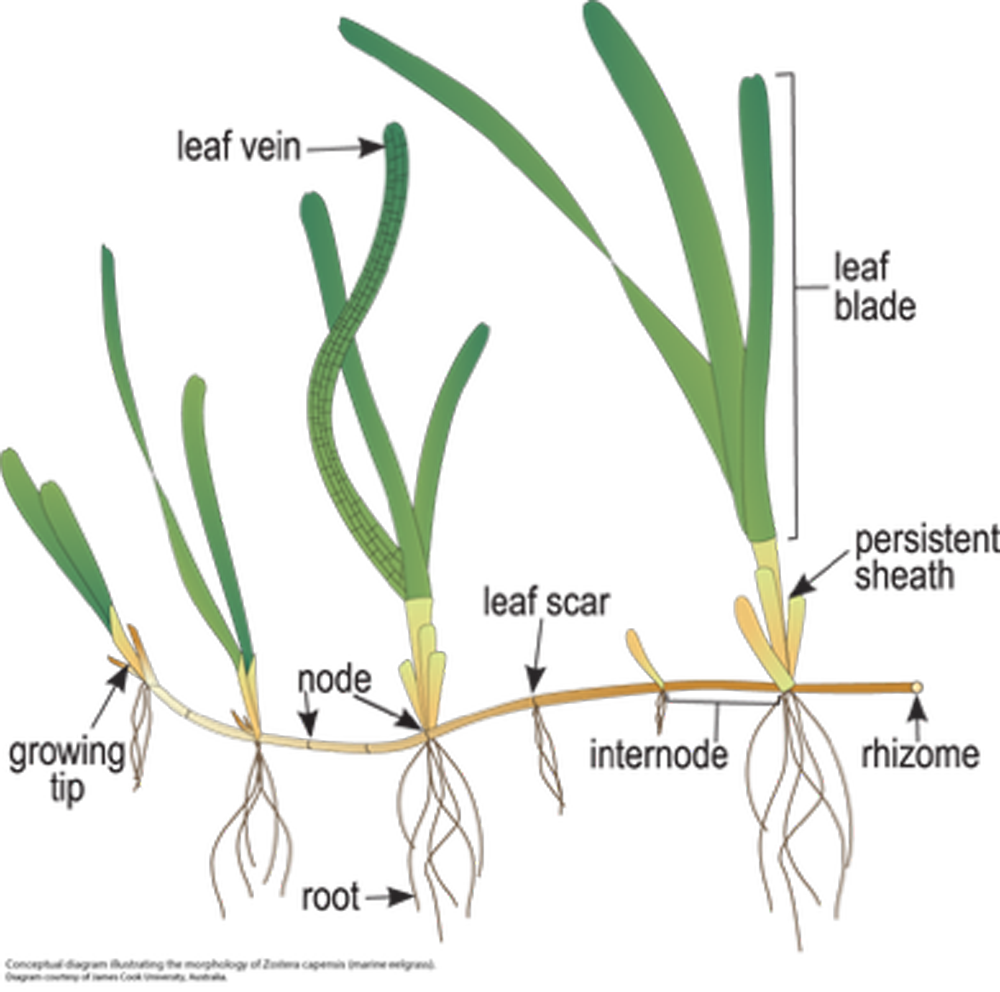How to become a
Storm Squad Member
The Posidonia australis fragments that you will be collecting will be used as donor shoots in the restoration.
To be able to be replanted, the fragments you collect must be healthy, living and with still some rhizome
(the “trunk”-like part at the bottom of the shoot where energy for growth is stored).
Not sure what this means?
Don’t worry, we’ll show you what you need to know!
For location-specific guides, check out the projects tab
Posidonia australis – what does it look like?
Healthy, living Posidonia australis is vibrant green, with long, wide leaves growing straight upward from a woody base that runs flat along the seafloor – the rhizome. These are just like the long, horizontal runners found on strawberry plants. There may be multiple shoots coming from a single rhizome, and often you will see several white roots attached as well.
The growing region of the plant, which we call the meristem, is at the base of the green leaves, and looks slightly pink, especially in the inner leaves.
When it is washed ashore, it looks:
· Bright, vivid green, sometimes a little brown on the tip
· 1-1.5cm wide leaves (about one finger width)
· Long leaves, usually between 10cm-40cm
Figure 1. Detailed illustration of Posidonia Australis
Source: James Cook University
Rhizome or no rhizome?
We can only replant Posidonia that has an intact rhizome.
Pics showing rhizome and close up.
The rhizome is the underground stem, with green leafy shoots growing vertically upwards at 1-3 cm intervals along the rhizome.
The rhizome looks brown and woody and is usually quite stiff.
If the leaves are not attached to a rhizome, at least 1-2cm long, then you should leave it on the beach.
Dead or alive?
When Posidonia australis dies, it loses the vivid green colour and turns a muddy brown.
We cannot replant dead Posidonia so it’s best to leave it on the beach.
The picture on the left shows green seagrass = ALIVE (Yes, pick it up!) The picture on the right shows brown seagrasses = DEAD (leave)
Posidonia or Zostera?
When collecting Posidonia fragments it is important to ensure you are collecting the correct species.
Posidonia and Zostera are two seagrasses that can be found in the waters of New South Wales. They look very similar when washed ashore and can easily be confused!
There are a few key differences in telling the difference between the two.
Zostera – Eelgrass or Ribbonweed (left)
Olive green/yellow/brown leaves
Soft, flexible leaves
Narrow leaf (0.1cm-0.5cm wide)
Shorter leaf (1cm-50cm)
Leaves in bundles of 4-6
Leaf tip rounded
Slender rhizome
Posidonia – Strapweed or Broadweed (right)
Bright green leaves
Thick, stiff, strap-like leaves
Wide leaf (1cm-1.5cm – a fingers width)
Long leaf (30cm-60cm)
Leaves in bundles of 1-4
Leaf tip square/ragged
Thick, woody rhizome
With wide, long leaves, Posidonia australis has the largest leaves of any seagrass in NSW. In comparison, Zostera leaves are far narrower, shorter and more flexible.
The easiest way to tell the difference between the two species is based on size. Are the leaves long, bright green and about as wide as a finger? Then congratulations, you have found Posidonia! If the leaves are narrow, in bundles, and the plant is small then you may have found Zostera – keep looking!
Collection permits
The NSW Department of Primary Industries allows persons to remove up to 20 kg/ day of seagrass ‘wrack’ from beaches or the intertidal zone for personal use without a permit.
As this restoration is also part of a research project, we are also operating under Section 37 Fisheries Management Act Collection Permit PN20/452, which allows the permit holder (Professor Adriana Vergés) and additional people (i.e. volunteers/ citizen scientists) to collect detached seagrass shoots.
When is best to go storm squadding?
Time of day
It is best to time your collection just after a morning high tide starts to recede, leaving the strands of broken Posidonia washed up on the beach. A good strategy to maximise the amount of living Posidonia you collect is to walk along the strand line (the line where most of the seagrass is washed ashore) when the tide is coming down, and back along the water's edge on the way back to your car.
Weather Conditions
Posidonia australis anchors itself to the bottom using sturdy roots but can be uprooted by currents or large swells.
The best times to comb the beach for fresh Posidonia fragments are just after events that may cause rough coastal conditions, such as:
Storms
East Coast Lows
At low tide after very windy days
When strong winds blow on onshore at your stretch of shoreline
At low tide during spring tides (new moon and full moon)
The absolute best time to search for Posidonia is when a strong wind has been blowing at low tide, especially during spring tides.
What do I do with the collected Posidonia?
Check out our Project pages for details on collection stations in your local area.
Safety!
There are many things that also wash up on beach that may sting, bite or cut, so it is a good idea to be aware of this when beachcombing. Most of these hazards can be managed by using common sense!
Do I need to bring anything when I go out to collect?
Yes! It’s a good idea to bring several things:
A damp bag/container to carry collected fragments
A bucket in the car to put your fragment bag in
Sun protection (hat, sunscreen, sunglasses)
Gloves, such as gardening gloves, for searching through seagrass ‘wrack’. These will protect you from any sharps such as glass, or potentially harmful marine critters.
A good bag option for collecting is a pale coloured plastic or a wet canvas bag, which prevents the Posidonia from the heat and stops it from drying out.
Optional things to bring:
A second bag to collect any plastic debris or rubbish you may find
When collecting, please don’t touch:
Jellyfish
Blue bottles (these can still sting after death!)
Fish – these often have sharp spines that can inflict a nasty cut
Blue ring octopus
Sharps (broken glass etc), unless you can safely collect and dispose of them
Please leave in the beach any Posidonia shoots that are not suitable for restoration (too brown/ too dry/ no rhizome). This forms important biomass when it gets swept back into the ocean.
Happy storm squadding!
Thank you for helping us restore Posidonia australis in our beautiful blue backyard.





